There has been much talk about Hermann Nitsch, known as “the artist of blood”, about who he was, what he did, what inspired him and how his painting was. There is still talk of the Theatre of Orgies and Mysteries, known as Das Orgien Mysterien Theater, and its actions. Today, however, we talk about the energy that the elements of his performative and pictorial art unleash during the exhibition organized by ABC-ARTE in Genoa, as a part of the contemporary one set up in Milan by ABC-ARTE ONE OF.
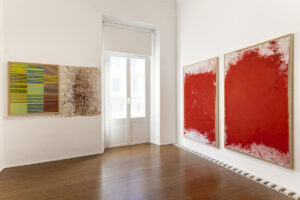
Hermann Nitsch. Cathartic Aversion. Paintings, actions, relics and musical Scores 1962-2020, ABC-ARTE, 2023, installation view. Courtesy ABC-ARTE, Genova-Milano, Fondazione Morra, Napoli
The exhibition, curated by Flaminio Gualdoni in collaboration with the Hermann Nitsch Museum in Naples, pays tribute to one of the most influential protagonists of the contemporary art scene, an eclectic artist who has distinguished himself as a performer, painter, musician, philosopher and playwright, and a leading figure in Viennese Actionism. His art is characterized by experimentation and controversy, pushing the limits of his actions to arouse controversy and boycotts. Nitsch has experienced moments of great fame, trials and condemnations, but has managed to establish himself as an indelible figure in the field of contemporary art.
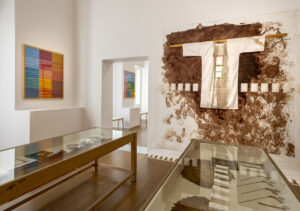
Hermann Nitsch. Cathartic Aversion. Paintings, actions, relics and musical Scores 1962-2020, ABC-ARTE, 2023, installation view. Courtesy ABC-ARTE, Genova-Milano, Fondazione Morra, Napoli
Through a documentary journey, the exhibition goes beyond the mere presentation of inanimate objects, which are veterans of his actions, and is charged with a very strong vitality, inevitably linked to the feeling of death. Nitsch’s works are characterized by a deep viscerality and a refined understanding of human dynamics. While observing his works, one finds oneself catapulted into a state of inner conflict, where ecstasy mingles with horror, and joy collides with suffering. This emotional complexity can be overwhelming, but that’s where the power of Nitsch’s art lies.
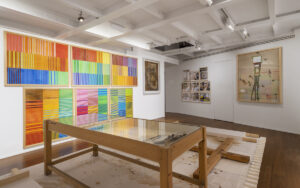
Hermann Nitsch. Cathartic Aversion. Paintings, actions, relics and musical Scores 1962-2020, ABC-ARTE, 2023, installation view. Courtesy ABC-ARTE, Genova-Milano, Fondazione Morra, Napoli
Entering the gallery, you immediately breathe a warm and enveloping air, given by the red, brown and yellow shades that mark the dividing lines in the artist’s works. In each room, works produced over several years – from 1962 to 2020 – coexist as in an ecosystem in which the paintings and the elements of the actions blend together. On the right, in the first room, we see two large canvases of 1986 entitled 18.malaktion Napoli Studio Morra, in which red predominates totally on the wall. Alongside, along the other wall, we can admire two other works: Oedipus King of 1971, a mixed technique that presents almost elementary traits, and Chromatic exercises of 2008, made with pastels on paper. We will find again the Chromatic exercises, with their vertical and horizontal lines characterized by a variety of shades, also in other rooms, placed as to want to contrast the visceral and powerful works of installations.
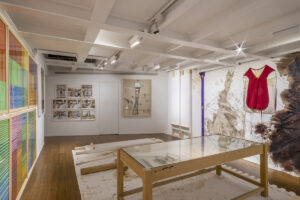
Hermann Nitsch. Cathartic Aversion. Paintings, actions, relics and musical Scores 1962-2020, ABC-ARTE, 2023, installation view. Courtesy ABC-ARTE, Genova-Milano, Fondazione Morra, Napoli
In the small corridor before the second room, we find the video of 158.aktion, a performance held in 2020 at the Hermann Nitsch Museum in Naples. The direction of the action was entrusted to Nitsch, with the support of Giuseppe Zevola, famous Neapolitan artist and his longtime collaborator. However, Nitsch’s adoptive son, Leo Kopp, who had been participating in his theatrical actions for many years, blew a whistle to the actors’ gestures. 158.aktion, carried out in symbiosis with the New Scarlatti Orchestra conducted by Andrea Cusumano, was articulated in a series of acts in which the actors poured pitchers full of blood, grapes and tomatoes on bare and semi-naked bodies lying on crucifixes.
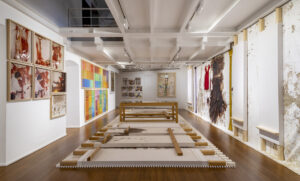
Hermann Nitsch. Cathartic Aversion. Paintings, actions, relics and musical Scores 1962-2020, ABC-ARTE, 2023, installation view. Courtesy ABC-ARTE, Genova-Milano, Fondazione Morra, Napoli
Starting from the second room, inside the entire gallery ABC-ARTE, there are installations composed of scenic instruments that was part of the works: blood-stained coats, stretchers, altars, scalpels, plasters, ropes, tubes, stills, sugar cubes and paper towels. All these elements might hurt the sensitivity of some viewers, but Nitsch did not aim to create a shock for the sake of it, but to provoke an authentic emotional reaction. His art has always challenged the conventions and restrictions of society, inviting viewers to reflect on their fears, desires and limitations. Continuing in this large container, it is understood that each room contains works and objects processed in different years of the artist’s life, creating a majestic patchwork of works that tell the very power of his entire existence. In the second room, on the wall to the left, we find the large canvas 85.malaktion of 2020, in which the red dominates the white, while the blue elegantly contrasts the surface.
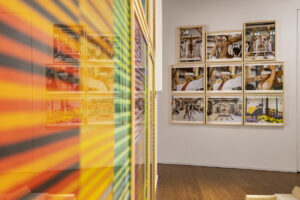
Hermann Nitsch. Cathartic Aversion. Paintings, actions, relics and musical Scores 1962-2020, ABC-ARTE, 2023, installation view. Courtesy ABC-ARTE, Genova-Milano, Fondazione Morra, Napoli
On the opposite wall, however, Die Eroberung Jerusalem 1971-2016, the size of 200×400 cm; in addition to the color of brown and sand, is enhanced the “sign”, in which a mass of lines and figures seems to give rise to grotesque representations of human organs, linked together and marked by a dense numbering. To the side of the room we find another piece of the series Chromatic exercises of 2008, while to the side and to the center stand out respectively the canvas and the installation 158.aktion of 2020. From this point, the whole exhibition assumes an expositive linearity, in which each room presents installations, paintings and ritual objects alternating and repeated. In other rooms, large bulletin boards welcome and protect scenic elements and surgical instruments used in theatrical actions, which require visitors a strong stomach, and the ability to conceptually process and assimilate the raw reality. Only in the fifth room we can admire photographs printed on paper and framed, representing some actions of 1978 and 2020.
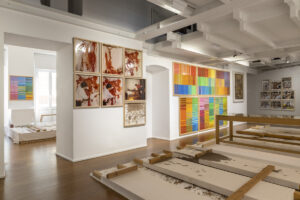
Hermann Nitsch. Cathartic Aversion. Paintings, actions, relics and musical Scores 1962-2020, ABC-ARTE, 2023, installation view. Courtesy ABC-ARTE, Genova-Milano, Fondazione Morra, Napoli
The installation, the objects of the performance and the color, as in a circle, merge into a dance within the spaces, in which the bodies of the protagonists of the actions become ghosts and the actors themselves become objects. In this dance, the bowels, bones, sacrifice, ecstasy, passion and resurrection are the real protagonists, together with the warm and dazzling light that emanates every line in space. What remains of the works recited are not only props, but actions that remain engraved in our minds, that we carry with us as naked, raw and visceral ghosts. Nitsch wanted precisely this: that each of us bring into his own existence something that goes beyond the mere vision of the works for its own sake: What remains of his actions? What remains of our actions? What remains of the actions? Perhaps the shadows of the past reflected on the actions of a present complicated by the circumstances of a distorted contemporary remain.
Benedetta Spagnuolo
Info:
Hermann Nitsch, Cathartic aversion
Curated by Flaminio Gualdoni
26/05/2023 – 30/09/2023
ABC-ARTE
via XX Settembre 11/A, 16121, Genoa
ABC-ARTE ONE OF
via Santa Croce 21, 20121 Milan
She graduated at the Academy of Fine Arts in Catania. During her lifetime, she has experienced various arts including sculpture, theatre, dance and photography, and the latter one became the springboard for her eclectic and innovative artistic path. In 2010, she approached the art curatorial world and started to write reviews and critical texts; later, she founded “Artisti Italiani – arti visive e promozione”, an organisation which deals with all the promotional aspects of contemporary art.






NO COMMENT